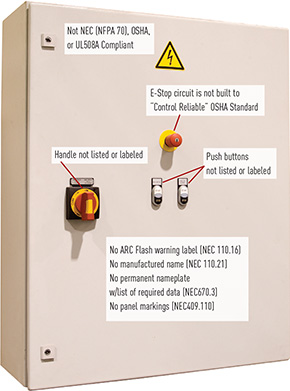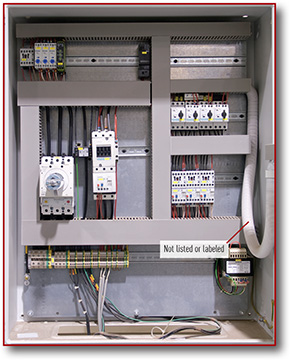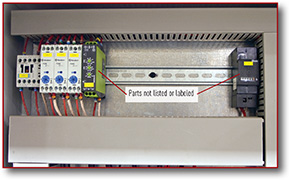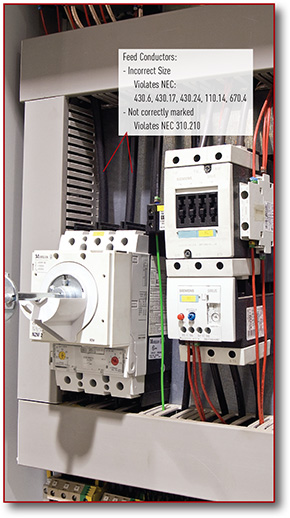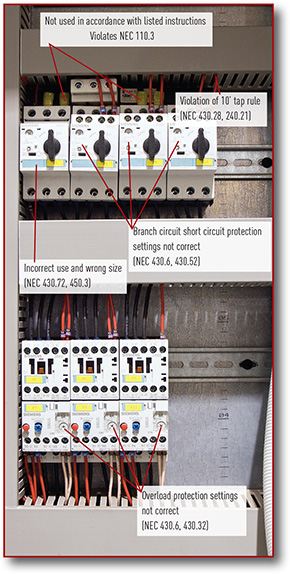Foreign OEM’s Need to Meet U.S. Standards
Foreign equipment manufacturers can make some of the finest equipment in the world, but they seldom comply with U.S. standards when it comes to their control systems. There are several reasons for this. Among these are:
- Companies are unsure of what standards to meet
- These companies are equipment manufacturers first and foremost and do not have the electrical resources in-house.
- Some countries, especially European countries, have high standards and they assume that meeting their standards will meet the U.S. standards.
Let’s start with what standards have to be met. The only standard that is mandated nationwide is the National Electrical Code (NFPA 70). This standard has been adopted by each of the 50 states as part of their state building code. The NEC is published every 3 years with 2014 being the latest edition. While the adoption of this standard lags behind the publishing date 42 states have adopted either the 2008, 2011, or 2014 NEC in its entirety. The remaining 8 states have adopted the NEC in the 2005 or earlier editions or they have local adoptions by jurisdictions. While this may seem confusing (and it is), following the guidelines in the latest (2014) version will insure compliance as the rules in this edition as it pertains to equipment have gotten more stringent, not less. To find out which edition has been adopted by which state, you can find this info HERE.
While there are several NEC Articles that apply to equipment and the control panels / MCC’s for that equipment, the following are considered some of the main Articles to read and learn:
- Article 100 – Definitions – always important when using the NEC
- Article 110 – Requirements for Electrical Installations
- Article 240 – Overcurrent Protection
- Article 250 – Grounding and Bonding
- Article 310 – Conductors for General Wiring
- Article 312 – Cabinets, Cutout boxes, and Meter Socket Enclosures
- Article 409 – Industrial control Panels
- Article 430 – Motors, Motor Circuits, and Controllers
- Article 450 – Transformers
- Article 670 – Industrial Machinery
OSHA also has a set of nationwide standards. These standards are typically for the end-user and not the OEM’s. However, it would be wise for OEM’s to at least adopt some of the major rules to insure their customers are compliant. There are two major rules that always need to be met. The first is from OSHA Section 1910.303(a). This states “The conductors and equipment required or permitted by this subpart shall be accepted only if approved, as defined in Section 1910.399”. This section states that approval means it is determined to be safe by a Nationally Recognized Testing Laboratory (NRTL). OSHA maintains a current list of these NRTL’s on its website. Please note that CE is not an approved label or listing as is commonly thought. This rule can be interpreted, and often is by the Authority Having Jurisdiction (AHJ) that not only do the parts need to be approved by a NRTL but the electrical system as a whole needs to be so approved. This is becoming more common and will soon be the rule rather than the exception.
This approval of components or final panel assembly by a NRTL comes with a major NEC rule that is often overlooked. NEC Article 110.3 (B) states that Listed or labeled equipment shall be installed and used in accordance with any instructions included in the listing or labeling. Failure to follow the manufacturer’s written instructions, in fact, voids the label or listing.
The second major OSHA rule is that systems must be “control reliable”. This phrase is widely accepted in the industry to mean that all control systems e-stop circuitry should be dual channel / monitored. Some would go as far as to say that all systems should be Safety Category 3 and / or Performance Level D. At a minimum, the e-stop circuit should be dual channel / monitored.
There are several local jurisdictions that require more stringent standards. Among these are:
- NFPA 79 – Electrical Standard for Industrial Machinery
- UL508 A – Underwriters Laboratory Standard for control panels
These are both “Nationally Recognized Standards” and as such often show up in company specs for inclusion in control systems. The OEM should at the least check with the local jurisdiction (most information is on internet) to see if either of these Standards are incorporated into local codes.
There are also “customer specific” specs such as Hazardous Location designations. The rules for these designations can be found in Articles 500 thru 506 in the National Electrical Code. The rules are specific and while there is some cross referencing to European standards there is not a direct correlation.
Common Mistakes made by Foreign OEM’s
The following is a list of the most common mistakes made by foreign OEM’s. Many of these same mistakes are also committed by U.S. OEM’s. National Electrical code references are added:
- NEC Article 110.3 (B) – Listed or labeled equipment shall be installed and used according to the listing or labeled instructions. As stated above, this is often overlooked.
- NEC Article 110.16 – An Arc-Flash Hazard Warning label are required on most electrical equipment including control panels but rarely does this happen.
- NEC Article 110.21 – this Article describes in detail the proper markings for electrical equipment. These include manufacturer’s markings, hazard markings, etc. Some of these markings are
- NEC Article 409.110 – Marking of Industrial Control panels
- NEC Article 670.3 – Machine Nameplate Data
- NEC Article 430.28 – Feeder Taps – this is one of the biggest areas of incorrect installation by OEM’s. Although too in depth to discuss here, this Article goes into very good detail for both the 10’ tap rule and the 25’ tap rule. Taps are very common in industrial control panels but rarely are the rules followed. There are additional rules for Taps in Article 240.21. The rules in that Article concern overcurrent protection for those tap conductors.,
- Article 310.120 – the cables and conductors that are used both on the equipment and in the control panel have to marked with required information. This rule is seldom followed.
- Last, but the biggest mistake of all is improper wiring sizing. The biggest issue is when sizing conductors for motors so that will be our focus. There are several mistakes made when sizing conductors so let’s start at the beginning.
- Article 430.6 – the ampacity of a motor will be based on the HP tables rather than any nameplate amperage. This is to insure that the same HP motors can be exchanged without the need for upgrading the conductors.
- Article 430.17 – basically repeats the same rule as above but specifically when calculating for largest motor on a multiple motor circuit
- Article 310 – the tables in this Article will show the conductor size based on the type of conductor and other factors. There are temperature correction factors and derating factors based on number of conductors.
